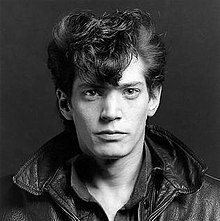Samuel Jones Wagstaff Jr. (4 November 1921 â€" 14 January 1987) was an American art curator and collector as well as the artistic mentor and benefactor of photographer Robert Mapplethorpe (who was also his lifetime companion) and poet-punk rocker Patti Smith. Wagstaff is known in part for his support of Minimalism, Pop Art, Conceptual Art and Earthworks, but his aesthetic acceptance and support of photography presaged the acceptance of the medium as a fine art.
Biography
Born on November 4, 1921, in New York City, Wagstaff was the son of Samuel Jones Wagstaff Sr., a wealthy lawyer from an old New York family, and his second wife, Polish émigré Olga May Piorkowska, a fashion illustrator who had worked for Harper's Bazaar and was previously married to Arthur Paul Thomas.[1] He had one sibling, a sister, Judith (Mrs Thomas Lewis Jefferson). His parents divorced in 1932, and Wagstaff's mother, a daughter of Polish inventor and scientist Col. Arthur Emil Piorkowski, married Donald V. Newhall, an artist.
After growing up on Central Park South, attending the Hotchkiss School and graduating from Yale University, and being a fixture on the debutante circuit, Wagstaff joined the US Navy in 1941 as an ensign, where he took part in the D-day landing at Omaha Beach in World War II. He later worked in the field of advertising in the 1950s, which he hated. He returned to school to study Renaissance art at the New York University Institute of Fine Arts, however, and turned his energies to the art world.
Career

In 1959, a David E. Finley art history fellowship took him to the National Gallery of Art in Washington, DC. He served as curator of contemporary art at the Wadsworth Atheneum from 1961 to 1968, and then at the Detroit Institute of Arts from 1968 to 1971. In addition to his curatorial work, Wagstaff was a noted collector, just like his father, who collected ephemera. After a conflict with the Detroit Institute of Arts' board of trustees over an earthwork by Michael Heizer, which had destroyed the immaculate museum lawn, he moved back to New York.
After seeing the exhibition "The Painterly Photograph, 1890-1914" at the Metropolitan Museum of Art in 1973 and meeting Robert Mapplethorpe in 1972, Wagstaff became convinced that photographs were the most unrecognized and, possibly, the most valuable works of art. He began selling his collection of paintings, using the proceeds to buy 19th-century American, British, and French photography. Then, influenced by Mapplethorpe, Wagstaff's taste veered toward the daring, and he began to depart from established names in search of new talent. His collection was soon recognized as one of the finest private holdings in the United States. In 1984 Wagstaff's photography holdings - comprising at least 2,500 masterworks - went to the J. Paul Getty Museum, for a reported price said to be in the neighborhood of $5 million.
Saying he needed the challenge of building another collection, Sam Wagstaff turned to 19th-century American silver. A show of more than 100 examples from his silver collection opened on March 20, 1987 at the Newâ€"York Historical Society.
Between 1976 and 1986, Sam Wagstaff donated his personal papers to the Archives of American Art, Smithsonian Institution. In 2008, the bulk of these papers were digitized and made available online (see the Samuel J. Wagstaff Papers, 1932â€"1985).
Personal life

Sam Wagstaff met his lifetime companion and protégé, photographer Robert Mapplethorpe in 1972 at a party. Mapplethorpe, whom Wagstaff called his shy pornographer, was also his guide to the gay demimonde of extreme sex and drugs that flourished in New York in the 1970s and 1980s. In the 1980s, Wagstaff gave Mapplethorpe $500,000 to purchase the top-floor loft at 35 West 23rd Street, where the photographer lived and had his shooting space.
Death

Wagstaff died of pneumonia arising from AIDS at his home in Manhattan on January 14, 1987, two years before Mapplethorpe.
Posthumously

A fund in Sam Wagstaff's name for the purchase of photographs was started in 1987 at the Metropolitan Museum of Art by art dealer Daniel Wolf.
In 2007, James Crump directed the documentary film Black White + Gray: A Portrait of Sam Wagstaff and Robert Mapplethorpe, which premiered at the 2007 Tribeca Film Festival. Because Mapplethorpe's story is already familiar to the public, the movie devotes most of its time to Wagstaff, whose personal history is a classic case of repressed or closeted homosexuality belatedly and furiously unleashed.
References
Further reading

- Crump, James, "Art of Acquisition: The Eye of Sam Wagstaff," published in the Archives of American Art Journal Vol. 46: 3â€"4, Fall 2007 (PDF), pages 5â€"13
- Hainley, Bruce, "The Eye of Sam Wagstaff", ArtForum, April 1997
- Official Movie Website for Black White + Gray: A Portrait of Sam Wagstaff and Robert Mapplethorpe, 2007, directed by James Crump
- Gefter, Philip, NY Times: "The Man Who Made Mapplethorpe", April 24, 2007, NY Times
- Hilton Als, Downtown Chronicles, "WAGSTAFF'S EYE", The New Yorker, January 13, 1997, p. 36
- Gefter, Philip, "Sam Wagstaff: The Photographist," 2010, published in the [2] Getty Research Journal No.2: pages 193-202
External links
- Archives of American Art. Samuel Wagstaff papers, 1932-1985
- Detroit Institute of Arts. The Samuel J. Wagstaff, Jr. records, 1956-1978
- Getty Research Institute. Samuel Wagstaff papers, 1860-1986
- Sam Wagstaff at the Internet Movie Database
- Black White + Gray: A Portrait of Sam Wagstaff and Robert Mapplethorpe at the Internet Movie Database